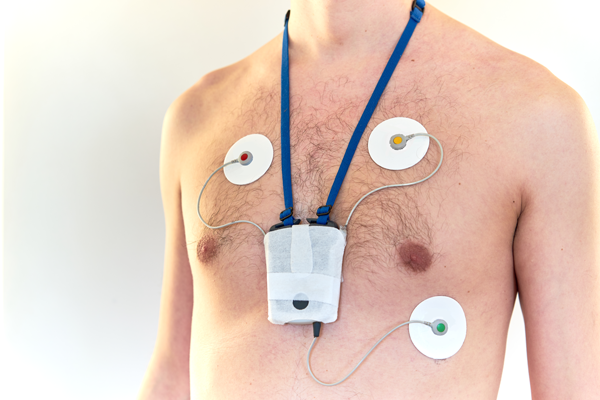摘要
If you have ever visited your doctor suffering from symptoms even mildly suggestive of a cardiac problem, you may have been subjected to the \"pleasure\" of wearing a Holter heart monitor. In this design solution, we review the traditional approach to portable heart monitoring and present an alternative solution.
Introduction
If you have ever visited your doctor suffering from symptoms even mildly suggestive of a cardiac problem, you may have been subjected to the “pleasure” of wearing a Holter heart monitor (Figure 1). After subsequent sleepless nights, you probably asked yourself, “Surely there must be a more comfortable way to do this”?

Figure 1. Holter heart monitor.
In this design solution, we review the traditional approach to portable heart monitoring and present a solution that takes a step towards consigning the Holter monitor to the annals of medical history.
What is a Holter?
Named after Dr. Norman Holter, a Holter monitor is a batteryoperated portable device that continuously measures and records your heart’s electrocardiogram (ECG) activity for 24 to 48 hours (or longer) depending on the type of monitoring used. The device is approximately the size of a small camera. It has several wires and electrodes that attach to the skin using adhesive patches. The Holter monitor records ECG signals as you go about your daily activities and as you sleep. Typical ECG signals allow a doctor to look at a patient’s heart activity at one point in time during an interval. However, abnormal heart rhythms and cardiac symptoms may come and go.
The advantage of wearing a Holter monitor is that it is used to detect fast, slow, or irregular heartbeats (called arrhythmias) over an extended period.
Unlike a telemetry unit, these monitors do not require a central receiving station and can be used at home, outdoors, or just about anywhere. A maximum of five leads are used for a Holter ECG monitor, as a 12-lead ECG (used in a hospital setting) is not practical for a patient to remain mobile. Data is most commonly retrieved from the monitor by removing the memory card. However, USB and other methods are also used. Principal concerns for Holter ECG monitor designs are low power, low noise, and small size. While Holter monitors pose no risk to the wearer, their rather cumbersome form factor makes them somewhat uncomfortable, particularly when trying to sleep. The wearer must also refrain from bathing or showering while wearing the device. The only other discomfort is having the adhesive patches removed from the wearer’s skin. Another limitation of the Holter monitor is that it only records ECG signals, but no other vital signs.
Towards a More Comfortable Alternative
Given the proliferation of wearable health and fitness monitors (typically worn on the wrist), a preferable scenario would be to include clinical-grade ECG monitoring in this type of device. A new type of wearable reference design (Figure 2) is a step towards this end. Featuring a single-channel integrated biopotential analog front-end (AFE), it makes ECG measurement much simpler.

Figure 2. MAXREFDES101# wearable reference design.
To start ECG measurement, the wearer must ensure that the two electrodes at the back of the device make good contact with the skin on the wrist. Recording is started by simply touching a third electrode, as shown in Figure 3. To prevent electrical interference with the ECG signal, the screen remains blank while measurements are being taken.

Figure 3. Measuring ECG.
ECG measurements are stored in the device’s onboard flash memory while raw data is downloaded to a PC using the USB interface. Post-processing is possible using the device’s evaluation software (Figure 4). Alternatively, the measurements can also be streamed to a Bluetooth®-enabled Android® device that runs the accompanying app.

Figure 4. Evaluation software analyzes ECG measurements.
Additional Health Measurements
Unlike most wearable health and fitness monitors, which only record heart rate and track movement, this development platform includes several other sensors that make it possible to record not only ECG, but also other health indicators. As shown in the Figure 5, it includes an optical sensor for heartrate variability measurement and a clinical-grade temperature sensor. The data measurements can be downloaded or streamed for later analysis.

Figure 5. MAXREFDES101# block diagram.
An onboard gyroscope and accelerometer compensate for user movement during measurements. A significant advantage of this design is that by providing open access to the raw unprocessed measurements, developers can investigate the performance of the onboard heart-rate algorithm or use the data to develop their own algorithms.
Many wearable health and fitness monitors are “closed systems” that do not provide access to raw data measurements. It is envisaged that in the future, healthcare wearables with open access to data will act as a source for massive cloud-based data repositories that will store information on human health. Mining this data with new statistical algorithms will assist with machine learning and in developing the type of artificial intelligence (AI) needed to predict the development of heart ailments before they occur. This will help speed up diagnoses and potentially lead to the development of new treatments (so called data-driven medicine).
Summary
Having reviewed the limitations of the traditional Holter health monitor as a portable ECG recording device, we have presented a new reference design that will potentially move portable ECG measurement beyond its current unwieldy, multi-lead, single function, chest-worn incarnation to that of a small, multifunction, wrist-worn device that requires only minimal contact with the wearer’s skin. This reference design will be of interest to hardware developers who wish to evaluate sensor performance for new clinical-grade monitors and to software developers who require raw data to create AI algorithms for machine-based learning.
Glossary
ECG: Electrocardiography (ECG or EKG) is the process of recording the electrical activity of the heart over a time interval using electrodes placed on the skin
PPG: Photoplethysmography is the volumetric measurement of an organ used which can be used to determine heart-rate variability (HRV)
AFE: Analog front-end
AI: Artificial intelligence




















